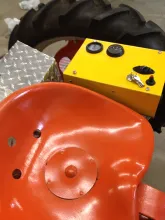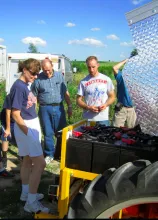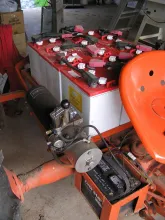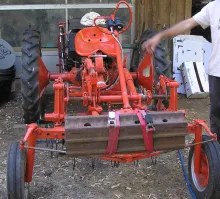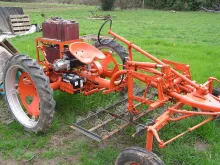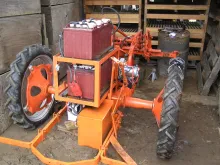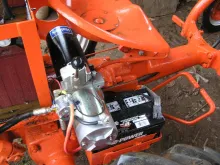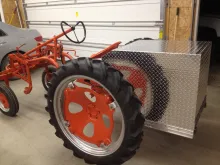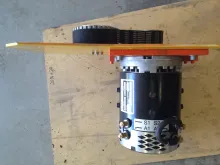https://www.youtube.com/watch?v=WIOY5jLW4qc
Problem addressed/functional need
If you want a tractor that is reliable, emissions-free, and quiet, you're going to have to build it yourself. Electric tractors aren't made commercially, but they do turn out to be extremely useful on small farms where low-horsepower cultivation work is necessary.
Functional Description/approach
The Allis Chalmers G tractor was built in the late 1940′s to be a cultivating tractor, using a relatively low horsepower gasoline engine that is bolted to the back of the tractor’s frame to allow the operator a clear view of the implements mounted on the belly of the tractor. It’s a great tractor for cultivating, but over time the engines can fall further and further out of good repair.
Farmer (and inventor!) Ron Khosla came up with instructions to convert these tractors to run on an electric motor and heavy duty batteries, giving you a fully functional, easy-to-maintain, quiet, no-emissions tractor. These electric G’s work great for cultivating, seeding, and some tinkerers have even rigged them up to do tillage and mowing.
How to use the tool
An electric G works just like a gasoline G, with a few exceptions. Because there is no need for the electric motor to idle like a gasoline engine, there is no need for a clutch to detach the transmission from the engine. To change gears, you just stop the motor and shift. The tractor can be used for several hours before a recharge is needed; of course, it depends on how you’re using it. We have only once run out of juice while cultivating on our farm, in 3 years. Also, we once got caught in a rain storm on our electric tractor; some water got into the controller, and it didn’t like that. But you shouldn’t be cultivating in the rain anyway.
The most important thing to remember with these electric tractors is to maintain the batteries very very carefully. This means recharging them immediately after use, every night; a battery that’s not at full charge begins to build up sulfation, which weakens its life significantly. It’s also important to monitor the level of sulfuric acid in your battery cells. And ideally you shouldn’t run your batteries all the way down to zero charge when using them, this also leads to early sulfation.
Actually, the most important thing to remember is that you’re dealing with a lot of voltage on these, and it’s very important to take safety precautions to ensure that you don’t get hurt or destroy your batteries or components. Follow the directions carefully and you should be ok.
If the mechanical hydraulics on your G still work (driven by a hydraulic pump powered by the drive train) you can use them– that’s what I do on mine. However, many people choose to add an electrically powered hydraulic pump to power the belly and rear hydraulic cylinders. These are usually 12v pumps, so many people will add a 12v battery into the mix exclusively to power this pump. See this setup on the photo to the right, the G at Persephone Farm in Lebanon, Oregon. Having your hydraulics set up like this means that you can operate them without sending power to the tractor’s motor; the hydraulics run very quickly and efficiently this way.
It’s also possible to re-charge your tractor using solar panels, or other sources of electricity generation. However, these batteries are quite cheap to charge using grid power– Ron Khosla estimated that his cost him $12 of electricity per year to recharge– and setting up solar will probably cost a couple thousand dollars, so it’s hard to justify unless you don’t have easy access to grid power.
Power Inverters
DC to AC power inverters can be purchased relatively inexpensively (under $250) and used to power 110V AC devices in the field. Grant Schultz, chief farm hacker at VersaLand Farm (WBM archived link from 2012-08-05 here) built a very stout 'Super G' that utilizes an inverter for power tools and 48V E-PTOs to power additional implements.
Bill of materials and Sourcing
A full list of materials and where to source them can be found at the Electric G Web Site parts page (WBM archived link from 2012-02-03 here)
Cost
The materials to convert an existing Allis G tractor (it can have a working or broken engine) are broken down into three components: the motor / controller and other off-the-shelf parts to be purchased from a supplier (about $1800); the custom fabricated parts that can be obtained through a machine shop (about $500); and the batteries (price varies, cost us $720 in March 2008). Most of the parts should last for years and years; the batteries, depending on how well you care for them, may need to be replaced after several years. At Hearty Roots Farm we’ve just completed our 3rd season using our first set of batteries, and they’re still going strong.
Construction/how to build
A complete set of step-by-step instructions and materials list is maintained by the original author, Ron Khosla, at the Electric G web site (WBM archived link from 2012-02-03 here).
There are various features that can be added on to this project. For example, the standard conversion is done with a 48v motor and four 12v batteries. If you want to have more “juice” there are a couple of options. You can use a 72v motor and more batteries, which will give you more power to do heavier work. If your preference is to work longer on a charge, you can use more battery mass– for example, on a 48v system, use eight 6v batteries, or six 8v batteries, which gives you the same voltage, but more mass, i.e. more lead and acid since all of these batteries are about the same size and weight regardless of voltage, which means more energy. The tractor in the photo at the top of the post, from 47th Avenue Farm in Oregon, has six 8v batteries; in one of the other photos above, from Mountain Bounty Farm in Nevada City, CA, the G has a whopping eight 6v batteries, which caused the back end to be so heavy that they had to strap some iron ballast to the front to even things out!
Next steps/goals/barriers
There are some great opportunities to create "add-ons" to the electric tractor. One possibility would be creating a "cruise control" module for the electric tractor. This would allow the operator to set a consistent speed without having to play with the throttle (aka potentiometer) while doing speed-sensitive work like seeding.
Credits for this post
The electric G conversion was masterminded, tested and codified by Ron Khosla. Ben Shute wrote this post, having done an electric G conversion on his own farm. Josh Volk took the photos of various west coast G’s. Grant Schultz contributed photos of VersaLand Farm's Super G.


